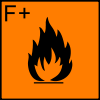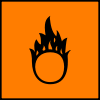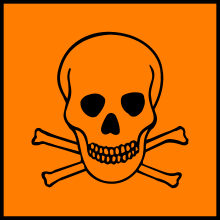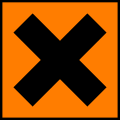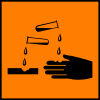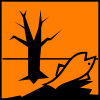European hazard symbols
European hazard symbols for chemicals are pictograms defined by the European Union for labelling chemical packaging (for storage and workplace) and containers (for transportation). They are standardised currently by the CLP/GHS classification.
GHS hazard pictograms
- The European Union CLP Regulation (for "Classification, Labelling and Packaging") was introduced as EC Regulation 1272/2008. It is based on the GHS system, to secure for "physical, health and environment hazards".

ADR European hazard sign, meaning highly flammable (33) — gasoline (1203)
- The European Agreement concerning the International Carriage of Dangerous Goods by Road (ADR) fixed harmonised pictograms for transportation. Vehicles carrying dangerous goods have to be fitted with orange signs, where the lower number identifies the substance, while the upper number is a key for the threat it may pose. See former pictograms below.
Former hazard pictograms
- Europe 1999 – 2007
The hazard symbols for chemicals were defined in Annex II of Directive 67/548/EEC. A consolidated list with translations into other EU languages was found in Directive 2001/59/EC (See the links section).
The 'n' in Harmful (Xn) stands for the French word nocif (harmful) and the Italian word nocivo (noxious).
 Block magnet |
 Explosive |
 Poison |
 Ionizing radiation |
 Suspended load |
 Truck driving |
 Self ignition |
 Electromagnetic radiation |
 Tripping danger |
 Falling hazard |
 Biohazard |
 Health danger and irritant |
 Dangerous batteries |
 Explosive atmosphere |
 Pinch |
 Can tip over when moving |
 Automatic Startup |
 Hand pinching |
 Slippery |
 Driven by conveyor belt inside the track |
 Entanglement hazard |
 Corrosive |
 Gas bottle |
 Cold |
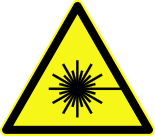 Laser radiation |
 Potential danger |
 Flammable |
 Electrical danger |
 Hot surface |
 Magnetic field |
 Optical radiation |
|||||
gollark: Electromagnetic waves are also weird, but not really quantum weird, mostly.
gollark: Photons are all quantum and weird.
gollark: Why photons and not just... electromagnetic waves?
gollark: I had to add a fallback copy of potatOS and associated libraries on my website in case of them doing it on a server I want to use it on.
gollark: Pastebin loves randomly blocking people.
References
- "Hazard symbols". MSDS Europe. p. http://www.msds-europe.com/id-487-hazard_symbols.html. Retrieved 23 August 2017.
External links


This article is issued from Wikipedia. The text is licensed under Creative Commons - Attribution - Sharealike. Additional terms may apply for the media files.

